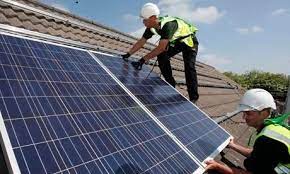A Guide to Residential Solar Panel Installation

As the world shifts towards sustainable energy solutions, residential solar panel installations have become an increasingly popular choice for environmentally conscious homeowners. Not only do solar panels contribute to a cleaner and greener planet, but they also offer substantial long-term cost savings. If you’re considering harnessing the power of the sun for your home, this comprehensive guide will walk you through the essential steps of residential solar panel installation.
Step 1: Assess Your Home’s Solar Potential
Before diving into the residential solar panel installation process, it’s crucial to assess your home’s solar potential. Factors such as location, roof orientation, shading, and available space will impact the efficiency of your solar panels. Consult with a professional solar installer or use online tools to calculate your home’s solar potential and determine the optimal placement for solar panels.
Step 2: Conduct a Home Energy Audit
A home energy audit helps you understand your household’s energy consumption patterns. By identifying areas of energy inefficiency, you can optimize your solar panel system size and design. Consider upgrading to energy-efficient appliances, sealing air leaks, and improving insulation to maximize the impact of your solar investment.
Step 3: Choose the Right Solar Panels and Components
Selecting the right solar panels and components is a crucial decision in the installation process. There are three main types of solar panels: monocrystalline, polycrystalline, and thin-film. Each has its advantages and disadvantages, so it’s essential to choose based on your specific needs, budget, and available space. Additionally, decide whether you want a grid-tied system, an off-grid system with battery storage, or a hybrid system that combines both.
Step 4: Obtain Necessary Permits and Approvals
Before installing solar panels, you’ll need to obtain the necessary permits and approvals from your local authorities. Your solar installer will typically handle the permit application process, but it’s essential to be aware of local requirements and timelines.
Step 5: Hire a Professional Solar Installer
While some homeowners may attempt a DIY approach, hiring a professional solar installer like Isolux Solar is highly recommended. An experienced installer will ensure that the system is installed correctly, efficiently, and safely. Research reputable local installers, check customer reviews, and obtain multiple quotes to make an informed decision.
Step 6: Roof Preparation
Before the solar panel installation begins, your roof may require preparation. This involves inspecting and, if necessary, reinforcing the roof structure to accommodate the weight of the solar panels. The roof should also be in good condition to prevent any issues in the future.
Step 7: Solar Panel Installation
The actual installation process involves mounting the solar panels on the roof or ground-mounted structure. The installer will connect the panels, install inverters to convert solar energy into usable electricity, and set up the electrical wiring. This step requires precision and expertise to ensure the system’s optimal performance.
Step 8: Inspection and Approval
After the installation is complete, a local building inspector will assess the system to ensure it complies with safety and building codes. Once approved, your solar installer will connect the system to the grid or commission your off-grid setup, making your home a clean energy producer.
Step 9: Maintain and Monitor Solar System
To maintain the efficiency of home solar panel system, you need to monitor and maintain your system regularly. Monitoring software allows you to track energy production and identify any potential issues. While solar panels are generally low-maintenance, occasional cleaning and inspections are recommended to ensure optimal performance.
Conclusion
Residential solar panel installation is a significant investment that pays off in both environmental and financial terms. By following these steps and working with a reputable solar installer, you can harness the power of the sun to reduce your carbon footprint and enjoy long-term energy savings. As solar technology continues to advance, installing solar panels at home becomes an increasingly viable and attractive option for homeowners committed to a sustainable future.






